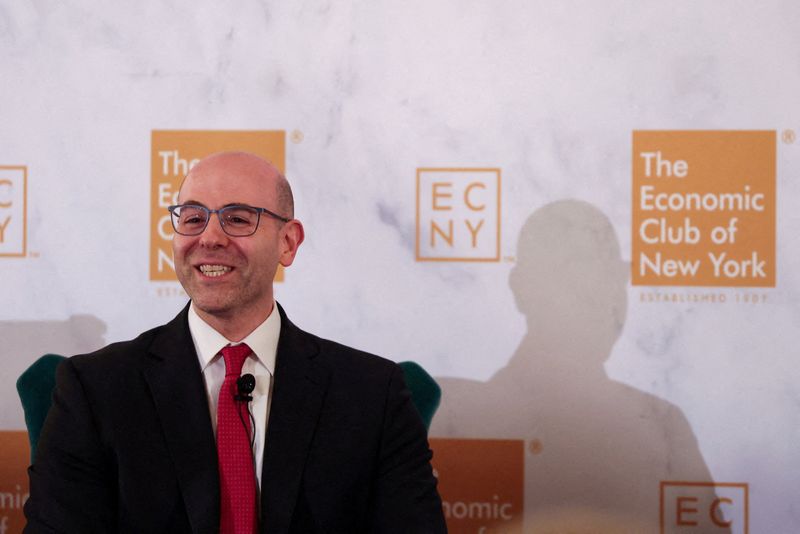By Howard Schneider and Ann Saphir
WASHINGTON (Reuters) -Federal Reserve officials on Monday continued pressing competing views of where the economy stands and the risks facing it, a debate set to intensify ahead of the U.S. central bank’s next policy meeting and in the absence of data suspended due to the federal government shutdown.
In her first public remarks since President Donald Trump launched a so-far unsuccessful attempt to remove her from her position, Fed Governor Lisa Cook portrayed a tug-of-war view of the policy debate, saying elevated risks to both the central bank’s employment and inflation mandates leave the December 9-10 meeting “live” for a possible rate cut, but not a lock.
“Keeping rates too high increases the likelihood that the labor market will deteriorate sharply,” though for now the labor market is “still solid,” she said during an event at the Brookings Institution.
On the other hand, Cook said, “lowering rates too much would increase the likelihood that inflation expectations will become unanchored,” though at this juncture “it is encouraging that most long-run inflation expectations … are low and stable.”
“The dual mandate is in tension … so I’m attentive to both sets of risks,” said Cook, who is embroiled in a legal battle with Trump over his effort to remove her as a Fed governor. The U.S. Supreme Court is due to hear arguments in the case early next year.
SHARP SPLIT, DOVISH ANXIETY
Speaking earlier in the day San Francisco Fed chief Mary Daly offered a similarly even-handed perspective, saying she viewed last week’s cut as further “insurance” against labor market weakening and has an “open mind” about the need for a similar move in December.
“It would be an unfortunate outcome, one that we would absolutely want to avoid, if we get inflation to 2% at the cost of millions of jobs,” she said. At the same time, she said, inflation remains too high and the Fed must make a decision that “balances those risks.”
The remarks, from two policymakers often aligned with the views of Fed Chair Jerome Powell, “give no indication the Fed is trying to socialize a planned December skip, but confirm sentiment on the Committee broadly has shifted in the direction of viewing a cut at that meeting as less clear-cut and less certain,” wrote Evercore ISI’s Krishna Guha.
The pair’s “lingering dovish labor anxiety,” he said, suggest the Fed is still about twice as likely to cut in December as not to cut. That’s about the same odds currently priced into interest-rate futures markets.
MIRAN SAYS FINANCIAL MARKET BUOYANCY NO BAR TO RATE CUTS
The 10-2 policy vote at the central bank’s October 28-29 meeting to lower the benchmark interest rate by a quarter of a percentage point to the 3.75%-4.00% range was only the third time since 1990 that dissents were cast in favor of both tighter and looser monetary policy at the same meeting.
Fed Chair Jerome Powell, speaking after the decision Wednesday, indicated an even deeper divide as he noted the “strongly differing views about how to proceed” at the December meeting and said another rate cut then “is not a foregone conclusion – far from it.”
In an appearance on the Bloomberg television program, Fed Governor Stephen Miran restated the case for deep interest rate cuts that he has voted for since joining the central bank’s Board of Governors in September. He argued buoyant stock and corporate credit markets are no reasons to think monetary policy is too loose.
“Financial markets are driven by a lot of things, not just monetary policy,” said Miran, who is on leave from his job as a top economic adviser in the White House, in explaining why he dissented last week against the Fed’s decision in favor of a bigger half-percentage-point reduction.
Miran’s preference for steep rate cuts remains an outlier, though others at the central bank, including Fed Governor Christopher Waller, have similarly indicated they feel short-term borrowing costs are restraining the economy, which allows room for further rate cuts.
Rising equity prices, narrow corporate credit spreads, and other factors don’t “necessarily tell you anything about the stance of monetary policy” at a moment when interest-sensitive sectors like housing are less buoyant and some parts of the private credit market appear under stress, Miran said.
He added that he is more sanguine than his colleagues about inflation, and feels that by keeping policy too restrictive the Fed is heightening the risk of a downturn.
GOOLSBEE NERVOUS ABOUT INFLATION
Kansas City Fed President Jeffrey Schmid, who dissented last week in favor of no rate cut because inflation remains too high, had argued that high equity prices and elevated high-yield bond issuance showed policy was only modestly restrictive.
Two non-voting Fed bank presidents – Dallas Fed’s Lorie Logan and Cleveland Fed President Beth Hammack – late last week said they too had opposed the rate cut, while Atlanta Fed President Raphael Bostic indicated discomfort at the prospect of more cuts.
Chicago Fed President Austan Goolsbee, who voted for last week’s rate cut, told Yahoo Finance Monday that he was leery of further rate cuts while inflation remains significantly above the central bank’s 2% target and is expected to accelerate through the rest of 2025.
“I’m not decided going into the December meeting,” he said. “I am nervous about the inflation side of the ledger, where you’ve seen inflation above the target for four and a half years, and it’s trending the wrong way.”
(Reporting by Howard Schneider; Additional reporting by Michael Derby and Ann Saphir; Editing by Andrea Ricci and Paul Simao)



Leave a Comment
Your email address will not be published. Required fields are marked *